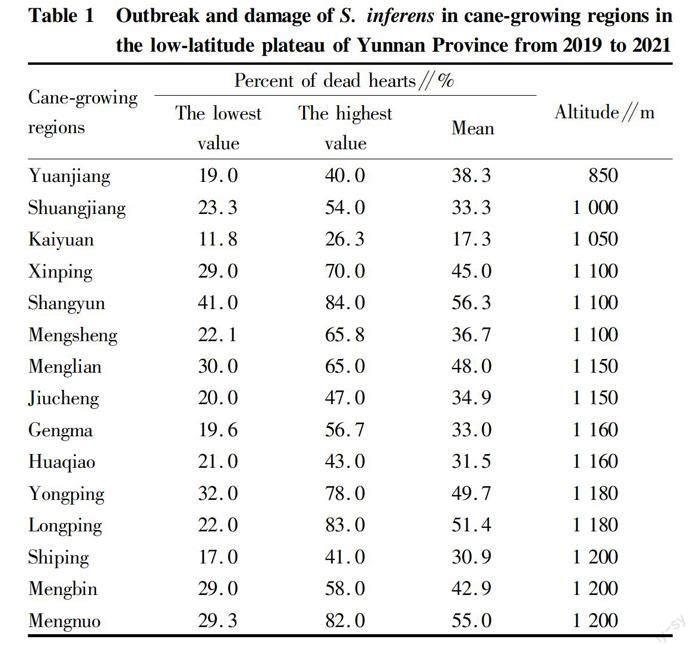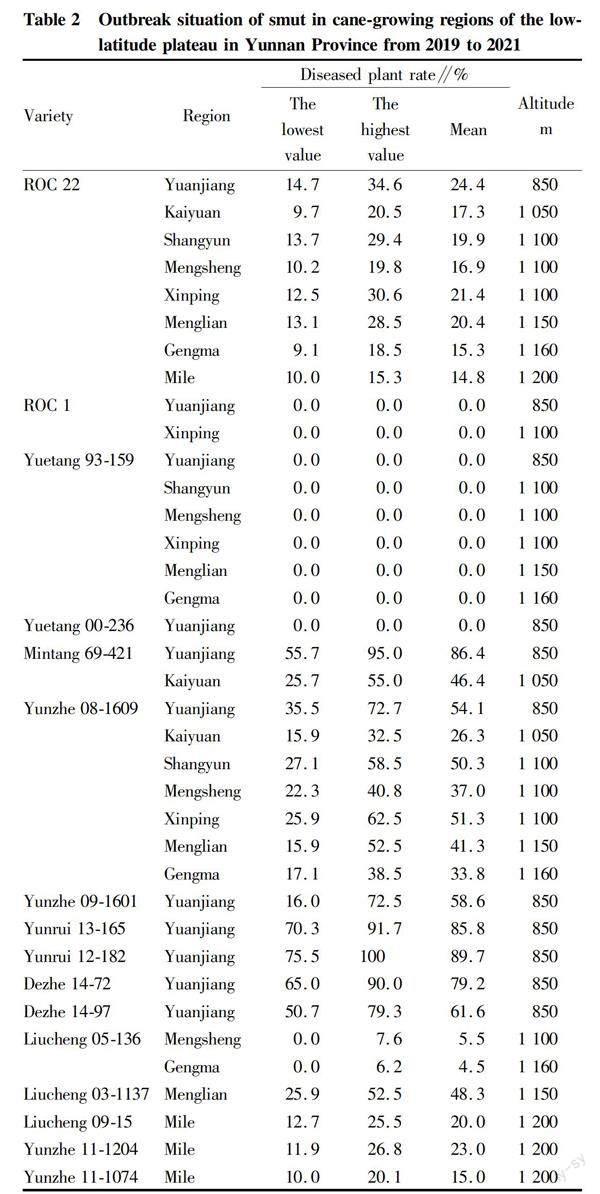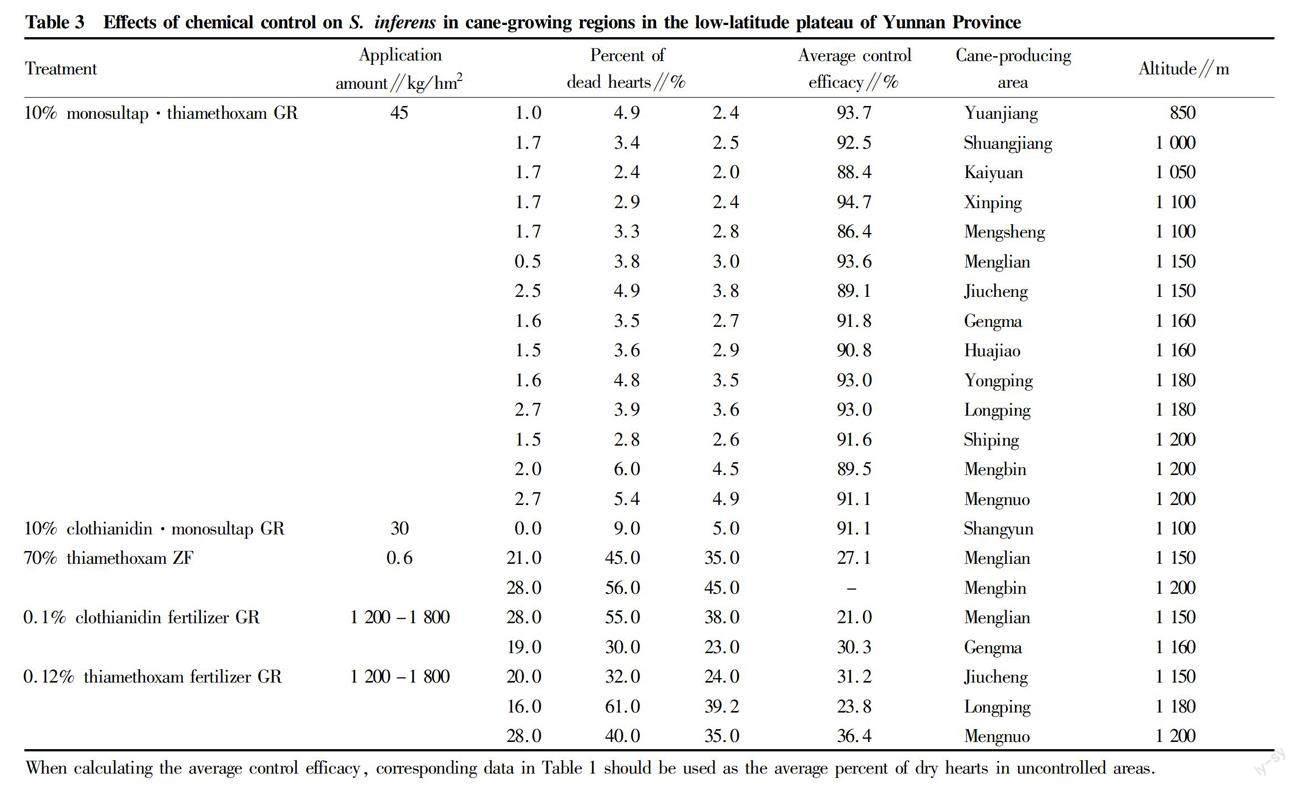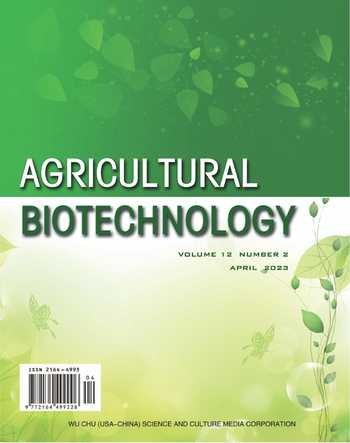Investigation on Outbreak of Sesamia inferens and Smut in Cane-growing Regions of Yunnan Province
Yongde MA, Xiaoyan WANG, Yinhu LI, Hongli SHAN, Rongyue ZHANG, Yingkun HUANG



Abstract [Objectives] This study was conducted to clarify the outbreak and disaster characteristics of Sesamia inferens Walker and smut in cane-growing regions in the low-latitude plateau of Yunnan Province, where there is continuous high temperature and drought in spring and summer.
[Methods] A systematic investigation and analysis was conducted on different varieties in different types of fields in 16 cane-growing regions with outbreak of S. inferens and smut in Yunnan from 2019 to 2021.
[Results] The outbreak of S. inferens and smut in cane-growing regions in the low-latitude plateau of Yunnan Province resulted in an average percent of dry hearts in the range of 17.3%-56.3%, and as high as 84.0% in severe cases. 70% thiamethoxam seed treatment dispersible powder and clothianidin or thiamethoxam fertilizer granules were ineffective against S. inferens, while 10% monosultap·thiamethoxam or 10% clothianidin·monosultap granules had a significant control efficacy on S. inferens. The average diseased plant rate ranged from 14.8% to 89.7% in susceptible varieties with smut, and was as high as 100% in severe cases. ROC 1, Yuetang 93-159, Yuetang 00-236, and Liucheng 05-136 had strong resistance, with an average diseased plant rate of 0-5.5% and the highest rate of 7.6%. S. inferens and smut both broke out in cane-growing regions with an altitude below 1 200 m. It is recommended to pay attention to disease and pest monitoring in cane-growing regions with an altitude below 1 200 m, and combine it with the management of new plants and ratoon plants to effectively prevent and control the first and second generation of S. inferens-infested seedlings from March to May. It is also recommended to strengthen the promotion and application of excellent disease-resistant varieties, so as to achieve a reasonable distribution of varieties and fundamentally control the outbreak and epidemic of sugarcane smut.
[Conclusions] This study provides a basis for the effective prevention and control of catastrophic S. inferens and smut caused by extreme climate.
Key words High temperature; Drought; Sesamia inferens; Smut; Outbreak
Received: January 1, 2023 Accepted: March 3, 2023
Supported by China Agriculture Research System of MOF and MARA (CARS-170303); Yunling Industrial Technology Leading Talent Training Project (2018LJRC56); Special Fund for the Construction of Modern Agricultural Industry Technology System in Yunnan Province.
Yongde MA (1970-), male, P. R. China, senior agronomist, devoted to research about promotion of sugarcane planting technology.
*Corresponding author. E-mail: huangyk64@163.com.
Sugarcane is a thermophilic crop, which is mostly planted in tropical and subtropical areas with a complex and variable climate and environment[1]. Asexual reproduction and perennial cultivation of sugarcane have resulted in few rotation areas for many years and long-term continuous cropping, leading to increasing accumulation of sugarcane diseases and pests. Multiple pests and diseases have combined to cause severe damage to sugarcane[2-3]. Especially in recent years, the continuous high temperature and drought in spring and summer have been very favorable for the reproduction and survival of sugarcane diseases and pests. Related studies have shown that the entire generation development of Sesamia inferens Walker, is proportional to temperature within a certain temperature range, and the higher the temperature, the shorter the development period. Its optimum survival temperature is 29 ℃, and the temperature for the strongest fecundity is 23 ℃[4-5]. Therefore, high temperature and drought in spring and summer increase the overwintering survival rate of S. inferens, leading to a significant increase in insect population accumulation year by year, a sharp increase in damage and loss rate, and a significant reduction in cane yield and sugar content[6-8]. However, high temperature and drought are beneficial for the survival and field accumulation of chlamydospores of Ustilago scitaminea Sydow[3,9-10], and most of the main sugarcane varieties in the region, ROC 22 and Liucheng 03-1137, are highly susceptible to the disease, leading to severe smut. Due to untimely and inadequate prevention and control in most sugarcane areas, a large number of sugarcane seedlings and plants often wither and die, resulting in huge economic losses[2-3,6]. Strengthening the dynamic and precise monitoring and prevention and control of the outbreak and epidemic of catastrophic sugarcane diseases and pests caused by extreme climate will be the primary task to ensure the efficiency improvement and sustained high-quality development of the cane sugar industry.
The cane-growing region in the low-latitude plateau of Yunnan Province is the second largest cane-growing region in China, with a typical high-temperature dry-hot climate. The continuous high temperature and drought in the spring and summer of 2019 to 2021 led to outbreaks of S. inferens in most cane-growing regions, causing disasters, and the main and recommended varieties, ROC 22, Liucheng 03-1137 and Yunzhe 08-1609, are experiencing an increasing incidence of smut, posing an increasingly severe threat to sugarcane production. However, the occurrence of damage to different sugarcane varieties in different cane-growing regions is unclear, and effective prevention and control lacks a foundation and scientific basis. Therefore, in response to the outbreak and control of S. inferens and smut in cane-growing regions in Yunnan Province with sustained high temperature and drought in spring and summer, a systematic investigation and analysis was conducted from 2019 to 2021, hoping to clarify the damage and disaster characteristics of different varieties in different cane-growing regions and provide scientific basis for the control of diseases and pests.
Materials and Methods
Investigation on outbreak and damage of S. inferens
During the occurrence period of dead heart seedlings due to S. inferens in cane-growing areas from March to June 2019, fields were randomly selected to investigate the percent of dead hearts due to S. inferens infection in areas such as Yuanjiang, Xinping, Kaiyuan, Shiping, Menglian, Mengbin, Shangyun, Yongping, Shuangjiang, Mengsheng, Gengma, Huaqiao, Jiucheng, Longping, and Mengnuo, Yunnan. Three points were randomly sampled, and 100 seedlings were investigated at each point. The total number of investigated seedlings and the number of dead heart seedlings were recorded to calculate the the percent of dead hearts.
Percent of dead hearts (%)=Number of dead heart seedlings/Total number of investigated seedlings×100.
Investigation on the outbreak and damage of smut
During the outbreak period of smut from April to June 2019 to 2021, plots planted with representative main and recommended varieties were randomly selected from cane-growing regions with outbreaks of smut such as Yuanjiang, Xinping, Mile, Kaiyuan, Menglian, Shangyun, Mengsheng, and Gengma in Yunnan Province to investigate the rate of plants infected with smut. Three points were randomly sampled, and 100 plants were investigated at each point. The total number of investigated plants and the number of diseased plants were recorded, and the diseased plant rate was calculated.
Diseased plant rate (%)=Number of diseased plants/Total number of investigated plants×100
Chemical control of S. inferens
Timely chemical control measures should be taken to control S. inferens in seriously damaged fields. The control pesticides were 10% monosultap·thiamethoxam granules (produced by Hebei Haoyang Chemical Co., Ltd.), 10% clothianidin·monosultap granules (produced by Hubei Tianmen Spring Plant Protection Co., Ltd.), 0.1% clothianidin fertilizer granules (produced by Guangxi Nongbida Biotechnology Co., Ltd.), 70% thiamethoxam seed treatment dispersible powder (produced by Hebei Haoyang Chemical Co., Ltd.), and 0.12% thiamethoxam fertilizer granules (produced by Guangxi Jinsui Pesticide Co., Ltd.). Pesticide application methods: At the end of February 2021, the pesticides were applied in conjunction with the management of ratoon cane. Specifically, 45 kg of 10% monosultap·thiamethoxam granules, or 30 kg of 10% clothianidin·monosultap granules, or 1 200-1 800 kg of clothianidin fertilizer granules, or 0.6 kg of 70% thiamethoxam seed treatment dispersible powder, or 1 200-1 800 kg of thiamethoxam fertilizer granules was mixed evenly with fertilizers according to the amounts of fertilizers applied per hectare, and the mixtures were then evenly spread on ditches and cane stumps and covered with soil in a timely manner. At the end of June when dead heart seedlings due to borers were in a stable stage, the total number of seedlings and the number of dead heart seedlings were recorded according to the method of "sugarcane Sesamia inferens outbreak investigation".
Average control efficacy of Sesamia inferens (%)=(Average percent of dead hearts in uncontrolled areas-Average percent of dead hearts in controlled areas)/Average percent of dead hearts in uncontrolled areas×100.
Results and Analysis
Outbreak of S. inferens
The investigation results on the outbreak of S. inferens are shown in Table 1. The investigation results of 15 cane-growing regions in Yunnans low-latitude plateau consistently indicate that the outbreak of S. inferens was severe, with a high percent of dead hearts. The degree of damage varied among different cane-growing regions, and the outbreak of S. inferens occurred in all cane-growing regions with an altitude below 1 200 m. The percent of dead hearts caused by S. inferens infestation was the lowest at 11.8% in investigated fields, and reached 84.0% in severe cases, with an average of 17.3%-56.3%.
Outbreak and epidemic situation of sugarcane smut
As shown in Table 2, the degree of damage caused by sugarcane smut varied among different sugarcane varieties in different cane-growing regions, and the outbreak and epidemic areas were all located in cane-growing regions with an altitude below 1 200 m. The main and promoted varieties, including ROC 22, Liucheng 03-1137, Mintang 69-421, Yunzhe 08-1609, and Yunzhe 09-1601, experienced severe outbreaks, with a diseased plant rate the lowest of 9.1% and as high as 95.0% in severe cases, 14.8%-86.4% on average. The demonstration new varieties Yunrui 13-165, Yunrui 12-182, Dezhe 14-72, Dezhe 14-97, Yunzhe 11-1204, and Yunzhe 11-1074 were highly susceptible to the disease, with the lowest diseased plant rate of 10% and the highest value of 100%, and an average in the range of 15.0%-89.7%. The main cultivated varieties, such as ROC 1, Yuetang 93-159, Yuetang 00-236, and Liucheng 05-136, had strong disease resistance, with the lowest and highest diseased plant rates of 0 and 7.6%, respectively, and an average in the range of 0-5.5%.
Effects of chemical control on S. inferens
The results of field control showed that the application of 70% thiamethoxam seed treatment dispersible powder and 0.1% clothianidin or 0.12% thiamethoxam fertilizer granules was ineffective against S. inferens, with the lowest and highest percents of dead hearts of 19.0% and 61.0%, respectively, and an average in the range of 23.0%-45.0%; and the average control efficacy of S. inferens ranged from 21% to 36.4%. The application of 10% monosultap·thiamethoxam or 10% clothianidin·monosultap granules had a significant control efficacy on S. inferens, with the lowest and highest percents of dead hearts of 0 and 9.0%, respectively, and an average in the range of 2.0%-5.0%; and the average control efficacy of S. inferens ranged from 86.4% to 94.7%.
Yongde MA et al. Investigation on Outbreak of Sesamia inferens and Smut in Cane-growing Regions of Yunnan Province
Discussion and Conclusions
From 2019 to 2021, the continuous high temperature and drought in spring and summer in cane-growing regions of Yunnan Province were very favorable for the reproduction and survival of sugarcane pests and diseases, leading to outbreaks of S. inferens and smut in most cane-growing regions, resulting in severe reduction of cane yield and sugar content. In this study, a systematic investigation and analysis was conducted on different sugarcane varieties in different types of field systems with the outbreak of the disease and pest in cane-growing regions of Yunnan Province, and the outbreak areas and disaster characteristics of S. inferens and smut in the low-latitude plateau of Yunnan were ascertained. S. inferens broke out in cane-growing regions with an altitude below 1 200 m, especially in the high-temperature and dry-hot cane-growing regions of Shangyun, Mengnuo and Longping, with an average percent of dead hearts over 51.4%, resulting in seriously insufficient effective stems, while the outbreak in the warm and cool cane-growing region of Kaiyuan was relatively mild, with an average percent of dead hearts of 17.3%. Sugarcane smut was easy to break out in cane-growing areas with an altitude below 1 200 m, especially in the high-temperature and dry-hot cane-growing region of Yuanjiang where the disease was severest. Nine varieties, including ROC 22, Mintang 69-421, Yunzhe 08-1609, Yunzhe 09-1601, Yunrui 13-165, Yunrui 12-182, Dezhe 14-72, Dezhe 14-97, and Liucheng 03-1137, were highly susceptible to the disease, with an average diseased plant rate over 24.4%, and as high as 95.0% in severe cases, resulting in crop failure. Meanwhile, the disease resistance of different sugarcane varieties and the efficacy of different pesticides were clarified, providing a basis for the effective prevention and control of extreme climate disasters such as S. inferens and smut.
70% thiamethoxam seed treatment dispersible powder and clothianidin or thiamethoxam fertilizer granules were ineffective against S. inferens, while 10% monosultap·thiamethoxam or 10% clothianidin·monosultap granules had a significant control efficacy on S. inferens, which is consistent with previous experimental reports[11-14]. S. inferens broke out in all cane-growing regions with an altitude below 1 200 m. Studies have shown that the period form March to May is the peak period for the first and second generation of dead heart seedlings caused by S. inferens[3]. It is recommended to pay attention to monitoring the pest situation in cane-growing regions with an altitude below 1 200 m, and combine it with the management of new plants and ratoon plants to effectively
prevent and control the first and second generation of S. inferens-infested seedlings from March to May. In production, 10% monosultap·thiamethoxam or 10% clothianidin·monosultap granules could be applied at a rate of 37.5-45 kg/hm2 after being evenly mixed with the amount of fertilizers applied per hectare. The mixtures could be evenly spread on sugarcane ditches and stumps, covered with soil and film in a timely manner. The control efficacy on S. inferens could reach over 79.2%, and the control efficacy on Ceratovacuna lanigera Zehntner could reach over 98.8%, ensuring the safe growth of sugarcane.
The degree of damage caused by sugarcane smut varied among different sugarcane varieties in different cane-growing regions of Yunnan Province. Varieties such as ROC 22, Liucheng 03-1137, Mintang 69-421, Yunzhe 08-1609, Yunzhe 09-1601, Yunrui 13-165, Yunrui 12-182, Dezhe 14-72, Dezhe 14-97, Yunzhe 11-1204, and Yunzhe 11-1074 were highly susceptible to the disease, while ROC 1, Yuetang 93-159, Yuetang 00-236 and Liucheng 05-136 had strong disease resistance. The outbreak and epidemic areas of sugarcane smut mainly occurred in cane-growing regions with an altitude below 1 200 m. Previous studies have shown that excellent varieties (lines) such as Funong 11-2907, Mintang 11-610, Yuegan 50, Ganhze 02-70, Yunzhe 13-1139, Yunrui 10-701, Dezhe 12-88, Guitang 08-1589, and Zhongzhe 1, which have been selected in recent years, have high resistance to smut[15]. It is recommended to strengthen the promotion and application of excellent varieties with disease resistance in areas with high incidence of sugarcane smut in low-altitude river valleys, in order to achieve a reasonable distribution of varieties and fundamentally control the occurrence and prevalence of sugarcane smut.
References
[1] ZHANG YB, DENG J, CHEN Y, et al. Research on the development and technological strategy of Yunnan plateau characteristic sugarcane industry[M]. Beijing: China Agriculture Press, 2013. (in Chinese).
[2] HUANG YK, LI WF. Color illustration for prevention and control of modern sugarcane diseases, pests, and weeds[M]. Beijing: China Agriculture Press, 2016. (in Chinese).
[3] HUANGY K, LI WF, ZHANG RY, et al. Color illustration of diagnosis and control for modern sugarcane diseases, pests, and weeds[M]. Singapore: Springer Nature Singapore Pte Ltd., 2018.
[4] JING PS. A study on the temperature effect of the development period of Sesamia inferens (Walker)[J]. Chinese Bulletin of Entomology, 1985(6): 247-252. (in Chinese).
[5] GU HN. A Preliminary study on the natural population dynamics of Sesamia inferens (Walker) [J]. Journal of Nanjing Agricultural University, 1987(1): 31-35. (in Chinese).
[6] LI WF, YIN J, HUANG YK, et al. Investigation of sugarcane losses caused by sugarcane borers[J]. Plant Protection, 2016, 42(4): 205-210. (in Chinese).
[7] LI WF, YIN J, HUANG YK, et al. The dynamics of population structure and control strategies of sugarcane borers in Yunnan[J]. Journal of Agriculture, 2014, 4(8): 35-38. (in Chinese).
[8] HUANG YK, LI WF, SHEN K, et al. The characteristics and control measures of sugarcane borer occurrence and damage in cane-growing regions of Yunnan Province[J]. Sugar Crops of China, 2014(2): 68-70. (in Chinese).
[9] BHUIYAN SA, CROFT BJ. Some biological parameters of the sugarcane smut fungus, Ustilago scitaminea[J]. Sugar Cane International, 2010, 28(1): 22-26
[10] WU WH, ZHENG XL, LI R, et al. The biological characteristics of the pathogen of sugarcane smut disease[J]. Chinese Journal of Tropical Crops, 2010, 31(8): 1388-1392. (in Chinese).
[11] LI WF, SHAN HL, HUANG YK, et al. Effects of 0.12% mixture of thiamethoxam GR with fertilizer against Ceratovacuna lanigera in the field[J]. Sugar Crops of China, 2017(3): 16-17. (in Chinese).
[12] LI WF, ZHANG RY, HUANG YK, et al. Control effect evaluation of 70% thiamethoxam ZF for sugarcane Ceratovacuna lanigera Zehntner and Baliathrips serratus Kobus[J]. Chinese Journal of Tropical Crops, 2017, 38(4): 700-703. (in Chinese).
[13] LI WF, ZHANG RY, WANG XY, et al. Control effect of new multifunctional sustained-release and long-lasting pesticide on sugarcane borer and woolly aphid[J]. Chinese Agricultural Science Bulletin, 2018, 34(31): 152-156. (in Chinese).
[14] ZHU YF, ZUO WJ, ZHUANG ZX, et al. A review of research progress in the development of clothianidin[J]. World Pesticide, 2017, 39(2): 28-33. (in Chinese).
[15] CANG XY, XIA HM, LI WF, et al. Evaluation of natural resistance to smut in elite sugarcane varieties (lines) [J]. Acta Agronomica Sinica, 2021, 47(11): 2290-2296. (in Chinese).
- 农业生物技术(英文版)的其它文章
- Improving the Heat Resistance of β-1,4 Glucanase by Introducing Disulfide Bonds
- Comparative Study on Biological and Commercial Characteristics of Mul-tiple Varieties of Broccoli (Brassica oleracea L. var. italica Plenck) and Vegetable Soybean (Glycine max (L.) Merr.)
- Effects of Bamboo Charcoal-based Biochar on Soil Enzyme Activity and Microbial Community Structure
- Summary of Short-vine Watermelon Breeding Practice
- Effects of Combined Application of Biochar-based Organic Fertilizer and Reduced Nitrogen Fertilizer on Soil Enzyme Activity and Yield of Purple Cabbage (Brassica oleracea var. capita rubra)
- Effects of Microelement Fertilizers on Main Economic Characters and Yield of Peanut

